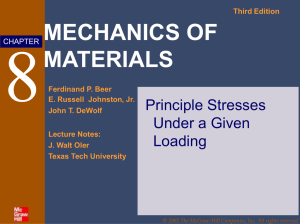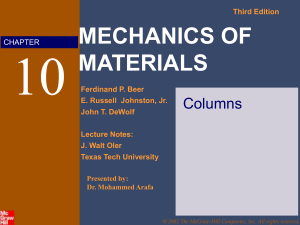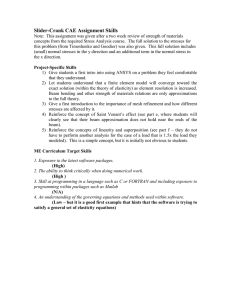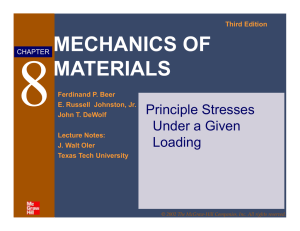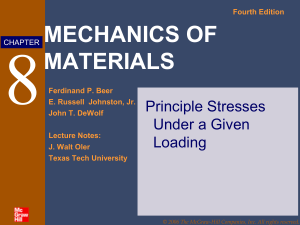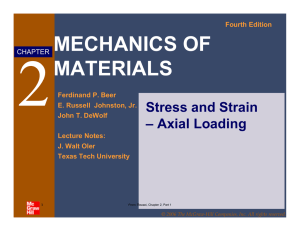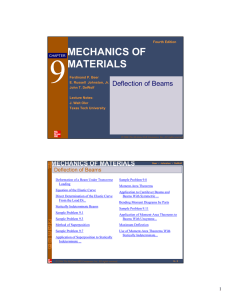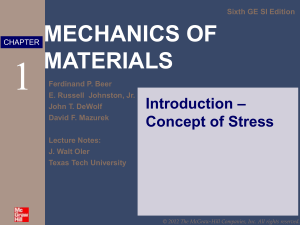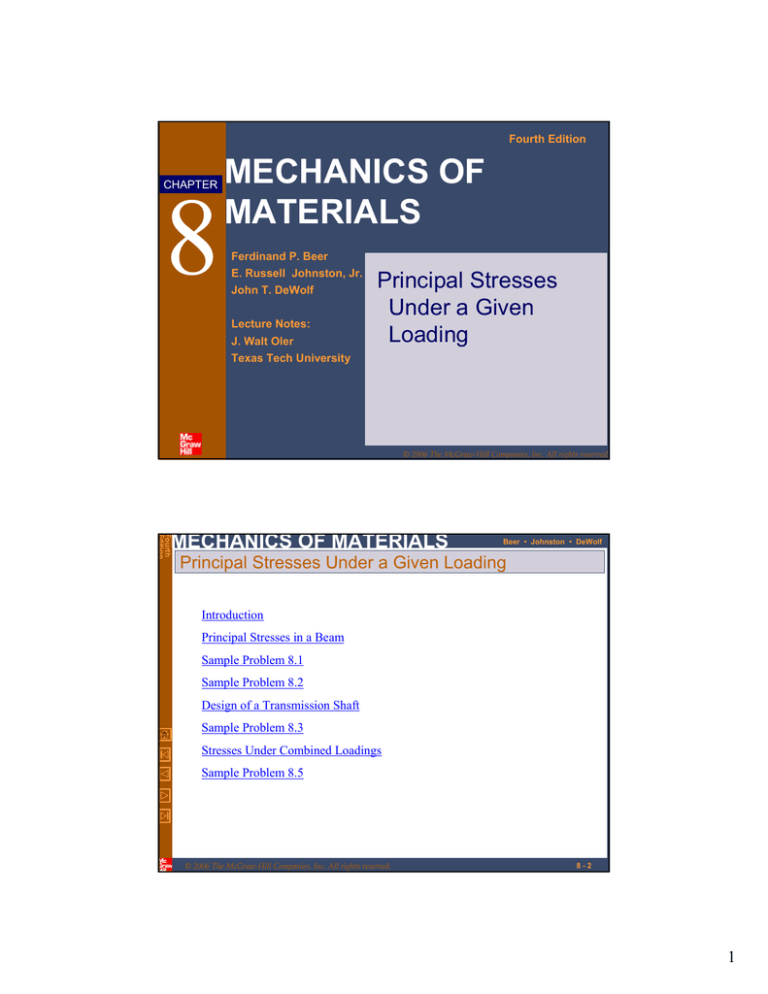
Fourth Edition
CHAPTER
8
MECHANICS OF
MATERIALS
Ferdinand P. Beer
E. Russell Johnston, Jr.
John T. DeWolf
Lecture Notes:
J. Walt Oler
Principal Stresses
Under a Given
Loading
Texas Tech University
© 2006 The McGraw-Hill Companies, Inc. All rights reserved.
Fourth
Edition
MECHANICS OF MATERIALS
Beer • Johnston • DeWolf
Principal Stresses Under a Given Loading
Introduction
Principal Stresses in a Beam
Sample Problem 8.1
Sample Problem 8.2
Design of a Transmission Shaft
Sample Problem 8.3
Stresses Under Combined Loadings
Sample Problem 8.5
© 2006 The McGraw-Hill Companies, Inc. All rights reserved.
8-2
1
Fourth
Edition
MECHANICS OF MATERIALS
Beer • Johnston • DeWolf
Introduction
• In Chapter 1 and 2, you learned how to determine the normal stress due to
centric loads.
• In Chapter 3, you analyzed the distribution of shearing stresses in a circular
member due to a twisting couple.
• In Chapter 4, you determined the normal stresses caused by bending couples.
• In Chapters 5 and 6, you evaluated the shearing stresses due to transverse
loads.
• In Chapter 7, you learned how the components of stress are transformed by a
rotation of the coordinate axes and how to determine the principal planes,
principal stresses, and maximum shearing stress at a point.
• In Chapter 8, you will learn how to determine the stress in a structural member
or machine element due to a combination of loads and how to find the
corresponding principal stresses and maximum shearing stress.
© 2006 The McGraw-Hill Companies, Inc. All rights reserved.
8-3
Fourth
Edition
MECHANICS OF MATERIALS
Beer • Johnston • DeWolf
Principal Stresses in a Beam
• Prismatic beam subjected to transverse
loading
My
Mc
σm =
I
I
VQ
VQ
τ xy = −
τm =
It
It
σx = −
• Principal stresses determined from methods
of Chapter 7
• Can the maximum normal stress within
the cross-section be larger than
σm =
© 2006 The McGraw-Hill Companies, Inc. All rights reserved.
Mc
I
8-4
2
Fourth
Edition
MECHANICS OF MATERIALS
Beer • Johnston • DeWolf
Principal Stresses in a Beam
© 2006 The McGraw-Hill Companies, Inc. All rights reserved.
Fourth
Edition
MECHANICS OF MATERIALS
8-5
Beer • Johnston • DeWolf
Principal Stresses in a Beam
• Cross-section shape results in large values of τxy
near the surface where σx is also large.
• σmax may be greater than σm
© 2006 The McGraw-Hill Companies, Inc. All rights reserved.
8-6
3
Fourth
Edition
MECHANICS OF MATERIALS
Beer • Johnston • DeWolf
Sample Problem 8.1
SOLUTION:
• Determine shear and bending
moment in Section A-A’
• Calculate the normal stress at top
surface and at flange-web junction.
A 160-kN force is applied at the end
of a W200x52 rolled-steel beam.
• Evaluate the shear stress at flangeweb junction.
Neglecting the effects of fillets and
of stress concentrations, determine
whether the normal stresses satisfy a
design specification that they be
equal to or less than 150 MPa at
section A-A’.
• Calculate the principal stress at
flange-web junction
© 2006 The McGraw-Hill Companies, Inc. All rights reserved.
8-7
Fourth
Edition
MECHANICS OF MATERIALS
Beer • Johnston • DeWolf
Sample Problem 8.1
SOLUTION:
• Determine shear and bending moment in
Section A-A’
M A = (160 kN )(0.375 m ) = 60 kN - m
V A = 160 kN
• Calculate the normal stress at top surface
and at flange-web junction.
60 kN ⋅ m
MA
=
S
512 × 10−6 m3
= 117.2 MPa
σa =
90.4 mm
y
σb = σ a b = (117.2 MPa )
103 mm
c
= 102.9 MPa
© 2006 The McGraw-Hill Companies, Inc. All rights reserved.
8-8
4
Fourth
Edition
MECHANICS OF MATERIALS
Beer • Johnston • DeWolf
Sample Problem 8.1
• Evaluate shear stress at flange-web junction.
Q = (204 × 12.6 )96.7 = 248.6 × 103 mm3
= 248.6 × 10−6 m3
(
)
V AQ (160 kN ) 248.6 × 10−6 m3
=
It
52.7 × 10−6 m 4 (0.0079 m )
= 95.5 MPa
τb =
(
)
• Calculate the principal stress at
flange-web junction
σ max = 12 σ b +
(12 σ b )2 + τ b2
2
102.9
⎛ 102.9 ⎞
2
+ ⎜
⎟ + (95.5)
2
⎝ 2 ⎠
= 159.9 MPa (> 150 MPa )
=
Design specification is not satisfied.
© 2006 The McGraw-Hill Companies, Inc. All rights reserved.
Fourth
Edition
MECHANICS OF MATERIALS
8-9
Beer • Johnston • DeWolf
Sample Problem 8.2
SOLUTION:
• Determine reactions at A and D.
• Determine maximum shear and
bending moment from shear and
bending moment diagrams.
The overhanging beam supports a
uniformly distributed load and a
concentrated load. Knowing that for
the grade of steel to used σall = 24 ksi
and τall = 14.5 ksi, select the wideflange beam which should be used.
• Calculate required section modulus
and select appropriate beam section.
• Find maximum normal stress.
• Find maximum shearing stress.
© 2006 The McGraw-Hill Companies, Inc. All rights reserved.
8 - 10
5
Fourth
Edition
MECHANICS OF MATERIALS
Beer • Johnston • DeWolf
Sample Problem 8.2
SOLUTION:
• Determine reactions at A and D.
∑ M A = 0 ⇒ RD = 59 kips
∑ M D = 0 ⇒ R A = 41kips
• Determine maximum shear and bending
moment from shear and bending moment
diagrams.
M max = 239.4 kip ⋅ in
V max = 43 kips
with V = 12.2 kips
• Calculate required section modulus
and select appropriate beam section.
Smin =
M max 24 kip ⋅ in
=
= 119.7 in 3
24 ksi
σ all
select W21× 62 beam section
© 2006 The McGraw-Hill Companies, Inc. All rights reserved.
8 - 11
Fourth
Edition
MECHANICS OF MATERIALS
Beer • Johnston • DeWolf
Sample Problem 8.2
• Find maximum shearing stress.
Assuming uniform shearing stress in web,
τ max =
Vmax 43 kips
=
= 5.12 ksi < 14.5 ksi
Aweb 8.40 in 2
• Find maximum normal stress.
σa =
60 kip ⋅ in
M max
= 2873
= 22.6 ksi
S
127in 3
9.88
y
= 21.3 ksi
σb = σ a b = (22.6 ksi )
10.5
c
τb =
σ max =
12.2 kips
V
=
= 1.45 ksii
Aweb 8.40 in 2
2
21.3 ksi
⎛ 21.3 ksi ⎞
2
+ ⎜
⎟ + (1.45 ksi )
2
⎝ 2 ⎠
= 21.4 ksi < 24 ksi
© 2006 The McGraw-Hill Companies, Inc. All rights reserved.
8 - 12
6

